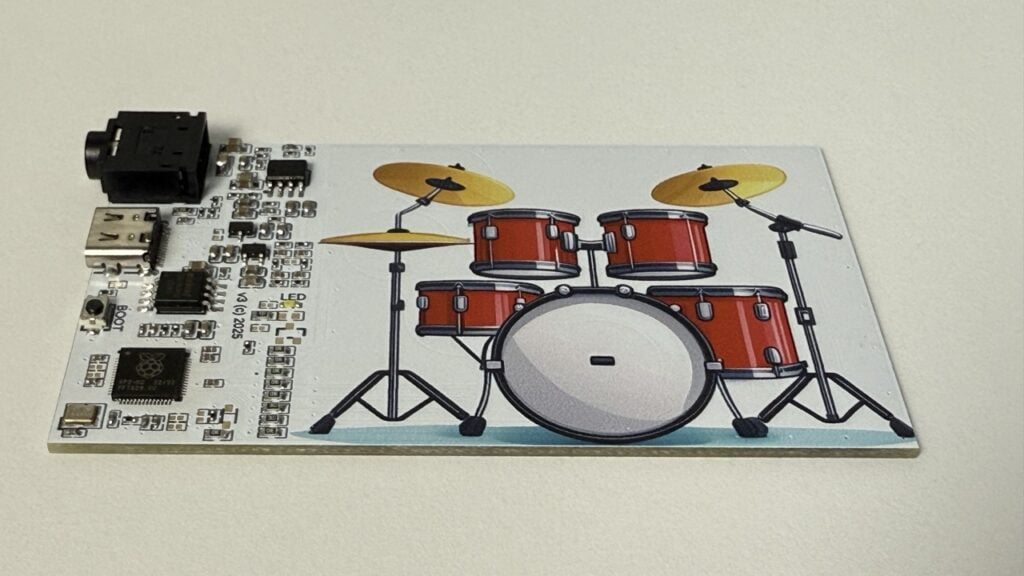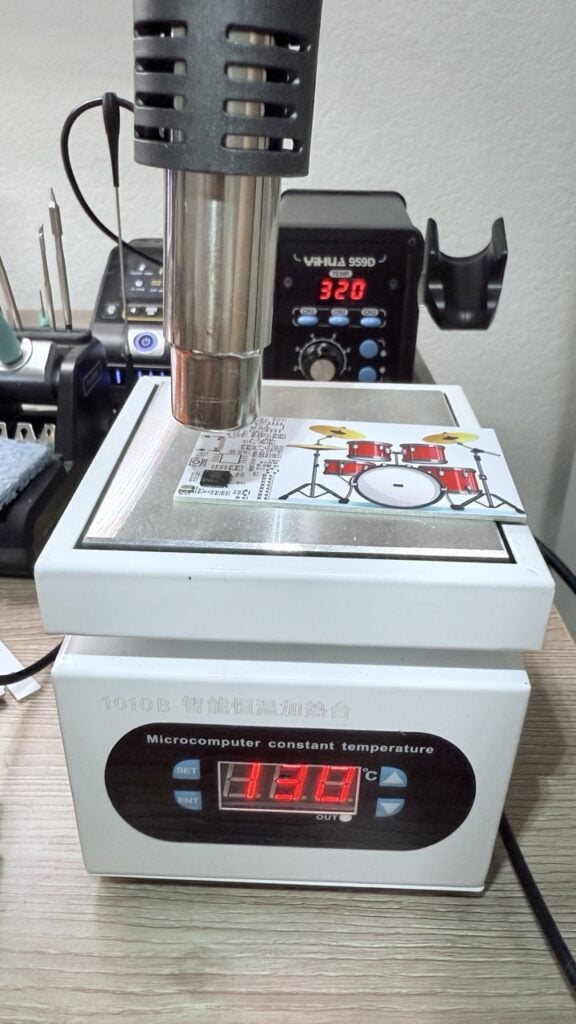The festive issue of Raspberry Pi Official Magazine is on sale from today and features one of the finest front covers our beloved illustrator, Sam Alder, has ever created. We wanted to share a Christmassy project from its pages, and have managed to shoehorn this RP2040-based build in on the grounds that it involves a drum and that there happens to be a Christmas song called ‘Little Drummer Boy’. The math checks out… as long as you don’t think about it too much.
Want to drum your name into someone’s memory at a networking event? Then Sergey Antonovich has got you covered. The embedded systems engineer has reinvented the age-old business card by turning it into a playable electronic drum kit — and we’d hazard a guess that this one won’t end up languishing, forgotten, in someone’s pocket.

Sergey designed it to be fun and intuitive: tap the printed cymbal to hear a crash
Sergey got the idea for the project some months ago. He enjoys building digital musical instruments — including ultra-portable, all-in-one digital accordions — and he was inspired by business cards that can fit an entire Linux system on a tiny PCB. Producing a business card that could be played felt like a natural fit. “It does three jobs at once,” he says. “It instantly grabs attention when you hand it over, it communicates exactly what I do, and it invites people to learn by reproducing the design.”

This led him to create a card that incorporated an F1C100s system-on-chip running Linux, as well as a TTP229 capacitive touch sensor. Recipients simply needed to power it up and listen via headphones connected to a 3.5mm TRS audio jack, while tapping on an image of a drum kit printed on the card. “Touchpads were hidden under the silkscreen art, so you could tap drums right on the print,” Sergey says. “It worked, looked great, and felt like a real instrument.”
Digital drumming
Yet Sergey wasn’t entirely happy, as the project proved costly and complex. “A Linux image/toolchain is doable, but heavy for beginners or classrooms,” he notes. “And even with trimming, a boot time of a few seconds was noticeable. I wanted instant-on.”

To resolve these issues, he turned to the Raspberry Pi RP2040 microcontroller. “It’s inexpensive and it uses external QSPI flash, which is large enough for multiple stereo drum samples,” he says. “It can also be programmed using CircuitPython, and this takes you from idea to music in an evening. There’s no heavy toolchain.”
Indeed, as Sergey points out, he really did have a build ready within hours. “I started from a CircuitPython build for a 16MB RP2040 board, prepared a tiny drum sample set, and wrote a short script that scans pads and plays stereo WAVs via audiomixer and audiopwmio.”
Feel the beat
The result has been a fresh RP2040 + CircuitPython version optimised for instant power-on via USB-C, which is ideal for beginners while also being cost-effective and quick to create. The touchpads are read directly by RP2040, so there is no need for an external touch-integrated circuit, and 16MB of external flash memory is more than sufficient for the code and sound samples.
Thanks to CircuitPython’s touchio module, RP2040 senses the pad capacitance directly. “A finger increases the capacitance, which leads to changes in the charge/discharge time that result in a reliable ‘touched’ flag,” Sergey explains. An LED provides instant visual feedback, and the sound is output via two of RP2040’s PWM channels.

Sergey now wants other people to make the project their own, which is why he has made it open source. But even though he has printed his own details on the reverse, including a QR code pointing to his LinkedIn profile, he says its use goes beyond sharing contacts.
“It’s a memorable handout that grabs attention the moment you tap it,” he says. “But the goal isn’t just to hand someone a cool card — it’s to give you a tiny, hackable instrument you can learn from and extend.”
Raspberry Pi Official Magazine #160 out NOW!
You can grab this issue from Tesco, Sainsbury’s, Asda, WHSmith, and other newsagents, including the Raspberry Pi Store in Cambridge. It’s also available from our online store, which ships around the world. And you can get a digital version via our app on Android or iOS.

You can also subscribe to the print version of our magazine. Not only do we deliver worldwide, but people who sign up to the six- or twelve-month print subscription get a FREE Raspberry Pi Pico 2 W!
The post Electronic drum business cards built on RP2040 appeared first on Raspberry Pi.
from News - Raspberry Pi https://ift.tt/Fi1HI2N
No comments:
Post a Comment